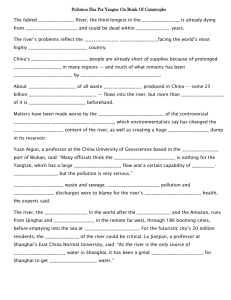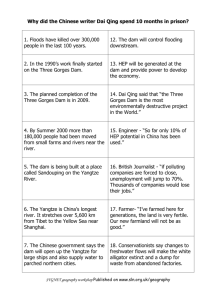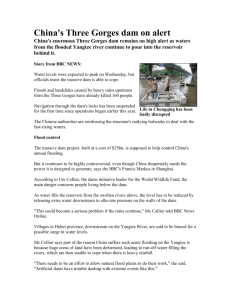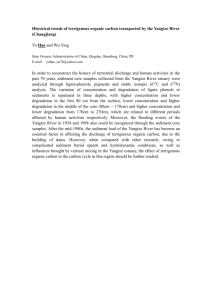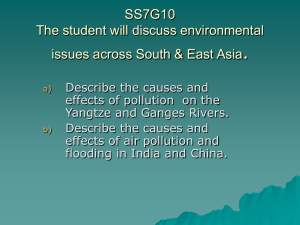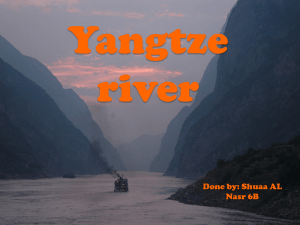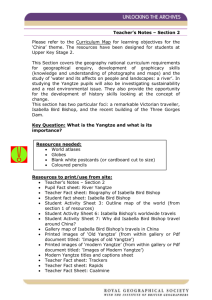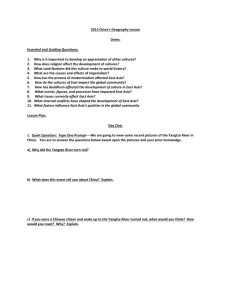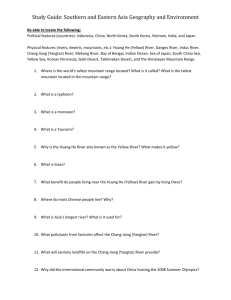Teacher's Notes – Section 2 Please refer to the Curriculum Map for
advertisement
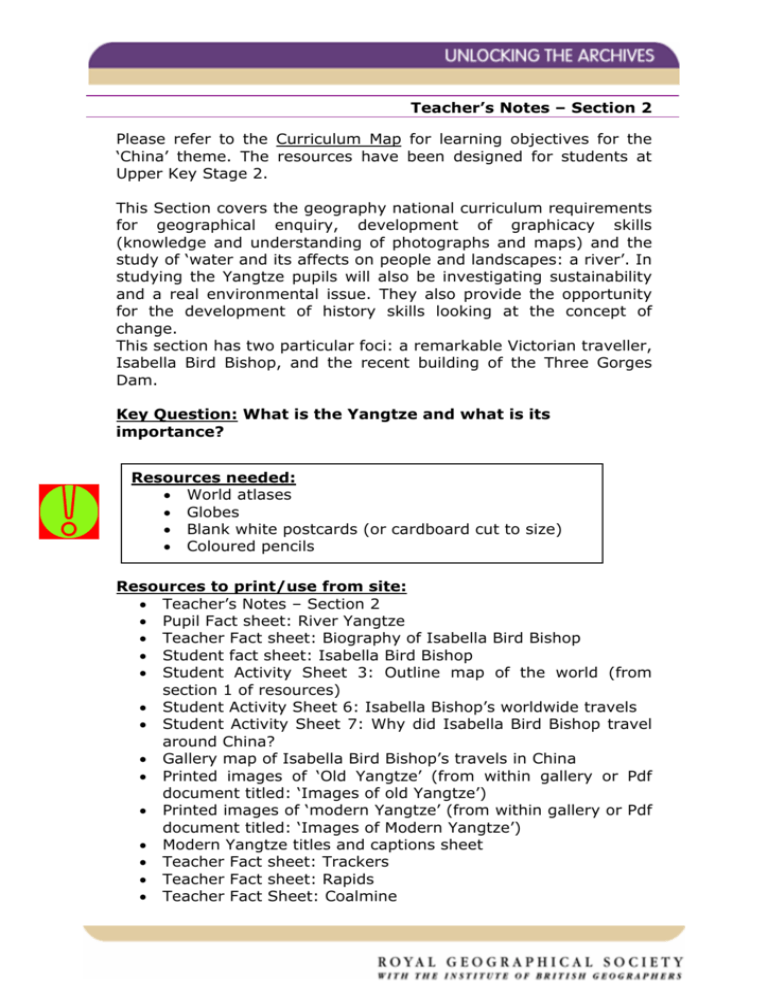
Teacher’s Notes – Section 2 Please refer to the Curriculum Map for learning objectives for the ‘China’ theme. The resources have been designed for students at Upper Key Stage 2. This Section covers the geography national curriculum requirements for geographical enquiry, development of graphicacy skills (knowledge and understanding of photographs and maps) and the study of ‘water and its affects on people and landscapes: a river’. In studying the Yangtze pupils will also be investigating sustainability and a real environmental issue. They also provide the opportunity for the development of history skills looking at the concept of change. This section has two particular foci: a remarkable Victorian traveller, Isabella Bird Bishop, and the recent building of the Three Gorges Dam. Key Question: What is the Yangtze and what is its importance? Resources needed: • World atlases • Globes • Blank white postcards (or cardboard cut to size) • Coloured pencils Resources to print/use from site: • Teacher’s Notes – Section 2 • Pupil Fact sheet: River Yangtze • Teacher Fact sheet: Biography of Isabella Bird Bishop • Student fact sheet: Isabella Bird Bishop • Student Activity Sheet 3: Outline map of the world (from section 1 of resources) • Student Activity Sheet 6: Isabella Bishop’s worldwide travels • Student Activity Sheet 7: Why did Isabella Bird Bishop travel around China? • Gallery map of Isabella Bird Bishop’s travels in China • Printed images of ‘Old Yangtze’ (from within gallery or Pdf document titled: ‘Images of old Yangtze’) • Printed images of ‘modern Yangtze’ (from within gallery or Pdf document titled: ‘Images of Modern Yangtze’) • Modern Yangtze titles and captions sheet • Teacher Fact sheet: Trackers • Teacher Fact sheet: Rapids • Teacher Fact Sheet: Coalmine In exploring the key question, pupils will address a sequence of smaller questions that help to organise their enquiry. What is the Yangtze? Activities: • Elicit children’s ideas about the Yangtze. You will probably find that some children know about the Yangtze but, if not, ask: ‘How can we find out?’ and follow their suggestions. • Check that children have discovered that the Yangtze (or Chang Jiang) is an important river, the third longest in the world, and can locate it in China. • Refer to the River Yangtze Fact sheet, on the IWB or provide small groups (2-3) of children with a printout from which to extract key information. Introduce the children to Isabella Bird Bishop. See the Teacher Fact sheet: ‘Biography of Isabella Bird Bishop’ for information, and use the ‘Student Fact sheet: Isabella Bird Bishop’ and Student Activity sheet 6 (Titled: Isabella Bird Bishop’s worldwide travels) with your pupils. • • • Provide each pupil with a copy of Activity sheet 6 (Titled: Isabella Bishop’s worldwide travel) and Activity sheet 3 (Titled: Outline map of the world). Ask them to complete the activity, either in class or as a homework activity. They will need access to world atlases (and globes, if available). This activity is included to extend pupils’ global locational or geographical general knowledge. Focus on Isabella’s visit to Asia, and China in particular. Ask ‘Why do you think Isabella visited Asia?’ for pupils to think about the many reasons why people travel – remember there is not one ‘right’ answer - and encourage imaginative oral responses. Use student activity sheet 7 (Titled: Why did Isabella Bird Bishop travel around China?), either on the IWB or 1 copy between 2 or 3 pupils. Thinking about reasons for travel, ask ‘Why did Isabella Bishop travel around China?’ Share, discuss and record ideas. Isabella wrote: ‘These journeys in China (concluding in 1897) . . . . were undertaken for recreation and interest solely, after some months of severe travelling in Korea.’ (in her Preface to: ‘The Yangtze Valley and Beyond’ (1899, reprinted by Virago, 1985). • • • Emphasise that, during her time in China, Isabella travelled up the Yangtze. You might wish to refer back to the River Yangtze fact sheet. Encourage pupils to find the River Yangtze in an atlas and on a globe. Notice how her travels upstream along the Yangtze would have taken Isabella far into China. As a class, look at ‘Mrs Bishop’s map’ of her journey (this can be found in the gallery of images), and follow the route from Shanghai, across the flood plain, through the Three Gorges (west of Yichang/Ichang) to ‘Chung king’ (now written ‘Chongqing’). Notice mention of ‘gorge’ and ‘rapids’. Mrs Bishop wrote the place names as she heard them, so they are difficult to match with the names on a modern map. Find Shanghai, the River Yangtze and Chongqing in an atlas and globe. You may also wish to access the website below for information on the Yangtze: http://en.wikipedia.org/wiki/Yangtze_River As an extension exercise to the above activities you may like children to: • • Write an exciting letter to a best friend or relative about a journey they have made. It can be local, national or global, maybe a day-trip or holiday. Encourage children to include as much detail and description as they can and illustrate their letter with drawings or photographs, like Isabella did. What did Mrs Isabella Bird Bishop see and experience? Isabella Bird Bishop not only wrote about her travels but also left a photographic archive which belongs to the RGS. • Many of these archive images of the Yangtze can be seen in the Gallery. Many of them were taken by Mrs Bishop (see each image for details of photographers). • Print a set of these photographs (either from the gallery or from the Pdf document labelled ‘Images of Old Yangtze’). Arrange these around the classroom and let children study them all. While they are looking at the photographs, ask children to think about the following questions: 1 2 3 How did she travel? Encourage children to describe river transport. What did she see? Children can comment on the gorges, the landscape, the river and the activities shown. What did she experience? Mention rapids, dangers and trackers. See the captions that accompany the ‘Old Yangtze’ photographs in the gallery for further details to share with children. These have also been listed in table format below (numbered 7 – 16 as they appear in the gallery), should you wish to print and use them as part of a sorting activity with your class. Gallery Image Title Image Number 6 Shanghai 7 Mrs Bishop’s house boat, Yangtze River 8 Mrs Bishops boat crew at dinner 9 Shin Tan Gorge, Yangtze River 10 Terraced dwellings on side of Yangtze River, China Information and points for discussion. This photograph shows people crowded round market stalls by a bridge over a river. Notice the style of buildings, the river transport and the human-powered rickshaws used for journeys by people who could afford to pay the driver. (Cycle-rickshaws and auto-rickshaws are still in use in Asia.) Notice how crew and passengers use a narrow plank to get on and off the boat. While the boat is moored, the boat’s sail is not in use, but is furled (rolled up) against the mast. Notice what is being used to provide shade on the boat - mats woven from palm or banana leaves. Notice the scenery on the other bank of the river. On the return journey Mrs Bishop sailed in a similar but smaller boat. Can you explain why she felt it was safe for her to travel in a smaller boat for the down-stream journey? The covering for shade has been removed and the crew are sitting around the boat. As several of them are smoking, dinner must be finished. Notice the bamboo poles tied to the side of the boat. What do you think these are for? Could they be for punting the boat in shallow water or for pushing the boat away from rocks? (What does bamboo come from?) Notice how close together the two steep, rocky banks of the river are as they form the gorge, and how narrow this makes the river. There are several different types of boat on the river, keeping well to the right to avoid the turbulent water on the left that could be rapids. Notice the small settlement high up on the river’s right bank, above the summer flood level. The person in the right foreground gives you an idea of scale. The narrow river is flowing round rocky mountain spurs through another gorge. In the left foreground a settlement is perched on a flattish terrace above the river. The flat areas in the left and right background are possibly terraced fields for growing crops, although the photographer thought they were dwellings – it is hard to tell – but, again, they are above summer flood level. As most of the boats on the river were sailing boats, making progress in light or no winds was difficult or 11 Trackers, China 12 Washing for Gold in the Yangtze 13 14 15 Mrs Bishop’s arrival with baggage coolies at a country inn "Rope breaks, for inch whirlpool. Drift down at 10 knots and then ashore. 1 mile down. Hole in bottom. Broken rudder". Our junk being towed. Boat used for running the Min Rapids impossible. So people were employed to pull the boat along. These people were called ‘trackers’. Notice how a large number of men are wearing harnesses attached to ropes. They are bent double as they strain to move the boat, especially difficult if they were pulling against the flow of the water. (See Teachers’ Information sheet: ‘Trackers’ which includes Mrs Bishop’s description of them.) The men are digging the river gravels, looking for sparkling fragments of gold. They will then ‘pan’ the gravel containing gold fragments to separate out the precious metal. The ‘pan’ is a shallow metal bowl into which the men put gravel and water. They swill it around and the heavy gold separates out from the lighter rock-fragment gravel. As rivers flow through rocky gorges they erode the rocks. If these are ancient rocks they may have contained gold. Gold is heavy, heavier than the eroded rock fragments, so it gets deposited in the gravel on the river banks, rather than transported further downstream. The men know from experience where the gold-bearing gravels accumulate. Mrs Bishop stayed on the boat and at a variety of places, including a country inn. Her baggage was carried by ‘coolies’. Notice how the baggage is in bamboo frames, one on each end of a plank of wood. Each coolie carried a plank on his shoulders with the baggage frames suspended at each end. A more substantial boat than Mrs Bishop’s, and nearly 20 years later, but the original caption tells of the dangers that confronted river travellers. Notice the steep river banks. The Min is a major tributary of the Yangtze. This multi-sailed wooden boat looks quite fragile, but is strong enough to sail down the rapids. Notice one sail is woven leaves and the other three are possibly something called ’grass straw’ or a textile made from hemp. It looks as if, when the three top sails are furled, the large woven sail folds down to provide roof cover for the front (bow) of the boat. Notice other similar boats in the background. At this time boats were sail-, steam- or human-powered, as the photographs show. The river was treacherous in places, with submerged rocks, deadly whirlpools and rapids. In more recent times rock has been blasted away from the river bed to make river transport much safer. And although there are still small sailing craft, the larger river transport is now engine-powered. • • You may like to read the Teacher fact sheet titled ‘Rapids’, which contains Mrs Bishop’s thoughts on rapids, to your pupils. You may also like to read the Teacher fact sheet titled ‘Trackers’ to pupils. It describes the difficulty and importance of their role. Either of these two sheets would form the stimulus for some creative writing or drama. Mrs Bishop also described the river bed: The river-bed (below Wan Hsien), forty feet below its summer level, is an area of heaped, contorted rock fragments, sharp-edged through which one or more swirling streams or violent rapids pursue their course, the volume of water, even at that season, being tremendous. At its highest level these upper waters are practically nonnavigable. Cliffs, mountain spurs and noble mountains rise from this chaotic river-bed, and every sharp turn reveals some new beauty. The dark green pine is but a foil to the feathery foliage of the golden bamboo on the steep terraced sides of tumbled heights; pleasant brown farmhouses are half seen among orange groves and orchards. Taken from: The Yangtze Valley and beyond by Isabella Bird Bishop. Chapter 11 – Rapids of the Upper Yangtze. • • When your pupils have seen the photographs, read the captions and explored the new geographical vocabulary in them, you may like to read this passage to the pupils, encouraging them to visualize the landscape. Provide them with a blank white card, about 10x15 cm. Repeat the reading, a phrase or sentence at a time as they create, and then colour, ‘a postcard from the Yangtze gorges’. Revisit ‘Mrs Bishop’s map’ of her journey in China. This is a sketch map of the Yangtze basin showing her route. The water divide (see and compare with Yangtze Fact sheet) is here shown in blue. As Mrs Bishop says: ‘The spelling of place names needs an explanation. I have not the Chinese characters for them, and in many cases have only been able to represent by English letters the sounds as they reached my ear; but wherever possible, the transliteration given by Consul Playfair in his published list of Chinese Place Names has been adopted, and with regard to a few well-known cities the familiar but unscholarly spelling has been retained. To prevent confusion the names of provinces has been printed in capitals.’ This provides an opportunity to discuss how we write down, for our own use, words in languages not written in the Roman alphabet. Why was the Yangtze important? • Develop the concept of the river as the major, if not only, routeway from the coast to the interior, through difficult, often mountainous terrain, as a transport artery and as a trade route, both along and across the river, connecting communities. It linked Shanghai with Chongqing (Chung king) and beyond. • Refer to the maps on the Pupil Fact Sheet: ‘River Yangtze’ Travelling on the return journey from Luchow to Chung King, Mrs Bishop describes a visit to a coal mine – coal is one of the many cargoes carried by the boats then and now. You may like to use the Teacher Fact sheet titled ‘Coal-mine’, describing landscape, coalmine and working conditions, especially with older pupils. (It could also form the stimulus for some drama or creative writing.) Is it still important today? Print a set of the images contained within the Pdf document titled ’Images of modern Yangtze’, the same images are also within the gallery and can also be printed from there. They were taken on a trip from Chongqing to Yichang, on a local rather than tourist ferry, in 2001. Also print a set of the titles and captions to accompany the images (these are contained in the document titled: Modern Yangtze titles and captions) and cut into strips. • As pupils observe, describe and compare the photographs, encourage them to use appropriate geographical terminology for the river and landscape. • Ask: How is the river similar to / different from the river that Mrs Bishop saw? • How / why has the river transport changed since Mrs Bishop’s time? • If using a set of printed photographs, arrange them around the classroom, give out the set of ‘Title’ cards and ask pupils to match them to the photographs. • Give out a set of the ‘Caption’ cards and ask pupils to match them to the photographs. Ask pupils to read the associated tasks and work through them, if appropriate. OR • If using the IWB with the whole class or a group, use the ‘Titles and Captions’ for reference, ask pupils to suggest a title for each photograph in turn, then work through the ‘Captions’. As a class or group discuss the task at the foot of each caption, if appropriate. Plenary To conclude this unit on the River Yangtze look at a topical development. This will give children an opportunity to demonstrate their knowledge and understanding of the river and the concept of change. It will also show the importance of the future in a geographical study – what is the future for the Yangtze and the people of the Yangtze valley? An idea for possible study is listed below. 3 Gorges Dam The 3 Gorges Dam is a huge, important and controversial engineering project still being developed on the River Yangtze at Sandouping, near Yichang. It is due for completion in 2009. • Talk about building a dam across rivers at the downstream end of the 3 Gorges. Check that the pupils know what a dam is and what its purpose is – (Hydro-Electric-Power (HEP) and flooding control downstream). Look at how the locks work to allow shipping past and how electricity is produced (by waterdriven turbines). • Tell the children that the 3 Gorges Dam has been built, and is creating a huge lake or reservoir as far upstream as Chongqing (an image of this can be seen in the series of modern images of the Yangtze). • See http://en.wikipedia.org/wiki/Three_Gorges_Dam/ for further information. • Look at the 2 Google Earth images of the Three Gorges Dam (document titled: 3 Gorges – Before and after). Tell the children that they are satellite images taken in 2006 and 2008. • Ask children: How many years between the 2 images? How has the river changed in that time? Why – what has happened to make it change? Recent photographs of the dam are readily available on the internet but an annotated image of the dam obtained from Google Earth has been included on the next page for your information. • Look at image number 24 in the gallery (this is a modern image of the Yangtze showing a settlement along the banks of the river). Talk about the water level rising to the level of the white board on the left-hand side when the huge lake behind the dam is full, sometime in 2009-2011. • Talk about the implications of this for the people who live in the towns and cities along the river. • You may like to hold a debate or create a role play about the building of the dam and its impact on the Yangtze valley, for example ‘Should the 3 Gorges Dam have been built?’ Children can be provided with different interest groups to represent, including: Government Officials, Environmental Campaigners, and Farmers. 3 Gorges Dam – Annotated Diagram for teachers Lake being created behind the Dam, as far up river as Chongqing. Flooding of valleys upstream from dam Provides an opportunity, when talking about flooding levels, to introduce the concept of contours, since the water surface is always horizontal. Series of 5 locks for shipping to bypass dam Direction of river flow River Yangtze Sandouping © Google Three Gorges Dam Water flowing over the dam Hydroelectric power station There are many concerns about the long-term safety of the dam. It is not really known what effect the weight of the tremendous amount of water in the lake will have on the stability of the land, which is a tectonically active area subject to earthquakes. More than 2 million people have been displaced by the building of the dam and the formation of its lake. How polluted will the water in the lake be, with so much industry upstream from the dam? Will the silt that the river carries be a problem? There are also many other questions about the sustainability of the dam. Further Reading: ‘The Yangtze Valley and Beyond’ Isabella Bird Bishop (1899) Describes her travels and the geography and people of the river in great detail, from the perspective of a remarkable Victorian woman. ISBN 0-86068-790-2 ‘The River at the Centre of the World’ Simon Winchester (1996) The author travelled upstream from Shanghai, almost to the source of the Yangtze. Chapter 9 ‘The New Great Wall’ is about the Three Gorges and the politics behind the Dam since it was first envisioned by Sun Yet-Sen, the father of Modern China, in 1919. ISBN 0-140-24912-5
